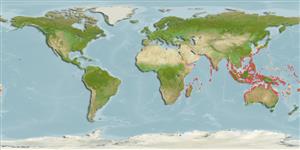Common names from other countries
>
Mugiliformes (Mullets) >
Mugilidae (Mullets)
Etymology: Crenimugil: Latin, crenulatus = cut, clipped + Latin, mugil = grey mullet (Ref. 45335).
More on author: Bleeker.
Environment: milieu / climate zone / depth range / distribution range
Ecologia
marinhas; Água doce; estuarina; catádromo (Ref. 46888); intervalo de profundidade 0 - 10 m (Ref. 86942). Tropical; 39°N - 37°S, 22°E - 178°W
Indo-Pacific: from South Africa through parts of Indonesia to parts of Micronesia and Melanesia; north to the Mariana Islands and southern Japan (Ref. 9812).
Length at first maturity / Tamanho / Peso / Idade
Maturity: Lm 36.0 range ? - ? cm
Max length : 100.0 cm TL macho/indeterminado; (Ref. 4393); common length : 35.0 cm SL macho/indeterminado; (Ref. 4967)
Espinhos dorsais (total): 5; Raios dorsais moles (total): 8; Espinhos anais 3; Raios anais moles: 9.
Found in coastal waters, including estuaries and rivers (Ref. 5213). Young fish frequent estuaries and also ascend rivers and coastal creeks (Ref. 2847). It feeds on algae, diatoms, detritus, and crustaceans (Ref. 9812). Oviparous, eggs are pelagic and non-adhesive (Ref. 205). Caught during the spawning period (Ref. 9812). Other methods include the use of stakenets, pouch nets, and barrier nets (Ref. 9812).
Life cycle and mating behavior
Maturidade | Reprodução | Desova | Ovos | Fecundidade | Larvas
Harrison, I.J. and H. Senou, 1997. Order Mugiliformes. Mugilidae. Mullets. p. 2069-2108. In K.E. Carpenter and V.H. Niem (eds.) FAO species identification guide for fishery purposes. The living marine resources of the Western Central Pacific. Volume 4. Bony fishes part 2 (Mugilidae to Carangidae). FAO, Rome. (Ref. 9812)
Categoria na Lista Vermelha da IUCN (Ref. 130435)
CITES (Ref. 128078)
Not Evaluated
Ameaça para o homem
Harmless
Utilização humana
Pescarias: espécies comerciais
Mais informação
ReferênciasAquaculturaPerfil para aquaculturaEstirpesGenéticaElectrophoresesHereditariedadeDoençasProcessamentoMass conversion
Ferramentas
Relatórios especiais
Descarregue XML
Fontes da internet
Estimates based on models
Preferred temperature (Ref.
115969): 24.1 - 29, mean 28 (based on 1174 cells).
Phylogenetic diversity index (Ref.
82804): PD
50 = 0.5625 [Uniqueness, from 0.5 = low to 2.0 = high].
Bayesian length-weight: a=0.01349 (0.00893 - 0.02037), b=2.99 (2.87 - 3.11), in cm Total Length, based on LWR estimates for this species & (Sub)family-body (Ref.
93245).
Nível Trófico (Ref.
69278): 2.2 ±0.11 se; based on food items.
Resiliência (Ref.
120179): Baixo, tempo mínimo de duplicação da população 4,5 - 14 anos (Preliminary K or Fecundity.).
Fishing Vulnerability (Ref.
59153): High vulnerability (60 of 100).
